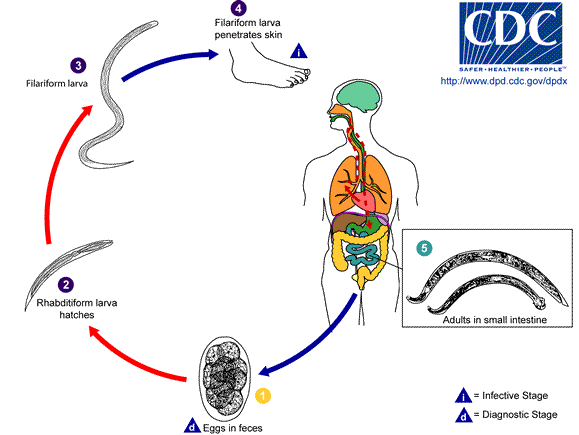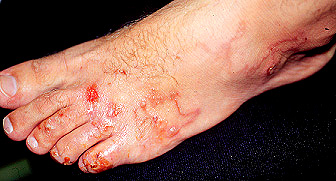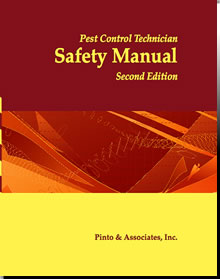Hookworm or "Creeping Eruption"
The name “hookworm” refers to the many species of nematodes (also called roundworms) that are intestinal parasites of animals. Two are specifically parasites of humans, but many of the animal hookworms also cause medical problems in people. It is these animal hookworms that are the primary safety issue for pest control technicians working in the United States.
 |
| Life cycle of human hookworm; animal hookworms have similar life cycles but the adults live in the intestines of animals such as raccoons, dogs, or cats. |
| Illustration from CDC, Division of Parasitic Diseases |
While an animal hookworm is primarily an intestinal parasite of domestic and wild animals, people become infected through contact with an infected animal’s feces, usually from dogs, cats, or raccoons. The results can be uncomfortable, disturbing, and even dangerous.
For most of their lives hookworms live inside the animal’s intestine, sucking blood from the intestinal wall. Hookworms are typically 1/4 to 1/3 inch (6-9 mm) long.
A mature hookworm can lay thousands of eggs a day, and there may be dozens or even hundreds of hookworms in the animal’s intestine. The eggs are passed in the animal’s feces, and hatch in about a week into tiny, active free-living larvae.
An infective larva crawls out of the feces onto the soil surface or up onto vegetation where it stands up on its “tail” waving its head, waiting for a host. If it finds a proper host, it bores into the skin, travels through the skin to a capillary, and follows the bloodstream to the lungs. It then moves up through the trachea where it is swallowed, enters the intestinal tract, and so completes its life cycle.
A person can become infected by walking barefoot through, or eating, infected soil (the common routes of infection by children) or by crawling through infected soil with bare arms, hands, legs, etc. (the typical exposure route for technicians).
 |
| Cutaneous larval migrans caused by infestation of the skin with hookworm |
| Photo from Washington University in St. Louis, Division of Dermatology |
The most common symptom is “creeping eruption,” more properly termed “cutaneous larval migrans,” inflamed, itchy tracks in the skin caused by burrowing hookworms. Because humans are an abnormal host, dog and cat hookworms are usually killed by the human immune system while still in the skin. While most human infections are mild, infection sometimes results in severe or even, very rarely, fatal disease.
Raccoon roundworms are particularly nasty; they occasionally migrate to the eyes or central nervous system.
Preventing Hookworm in Pest Control Work
Prevention is straightforward.
- Do not crawl without protection (meaning coveralls, gloves, and no bare skin) in crawlspaces or other sites that may be contaminated with animal feces.
- Wash up thoroughly after working in such sites.
- If you see “creeping eruption” tracks on your skin, see a physician.
